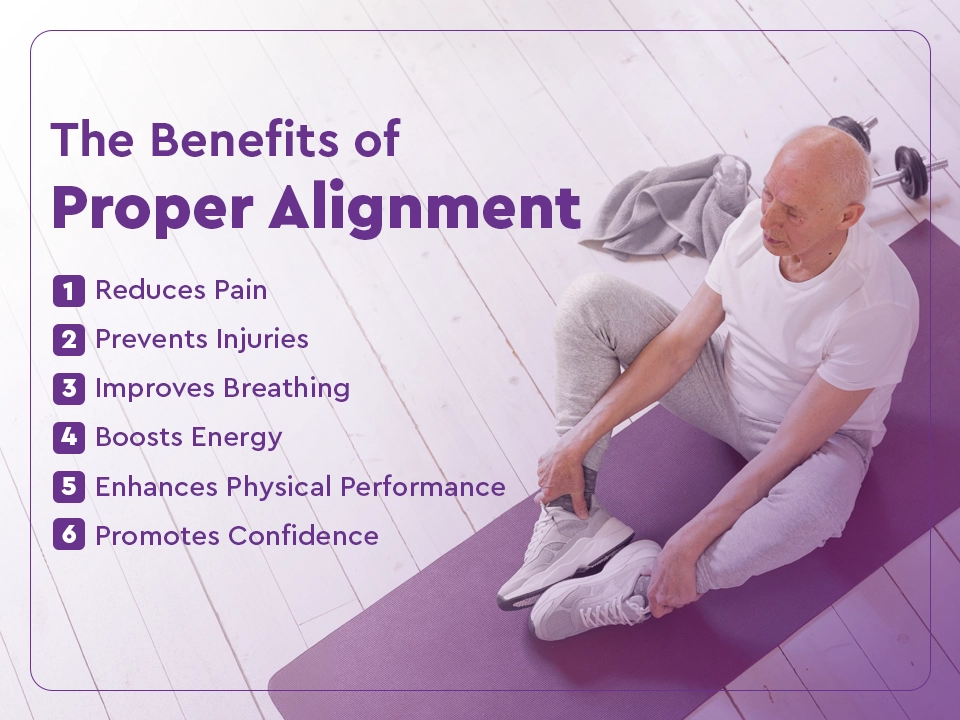Introduction
Proper posture is essential for maintaining overall health and preventing discomfort. When your body is aligned correctly, it reduces the strain on muscles, joints, and ligaments, minimizing the risk of pain and injuries. Poor posture, on the other hand, can lead to a variety of health issues, such as chronic back pain, muscle tension, and even headaches. The way you sit, stand, and sleep plays a significant role in how your body functions and feels throughout the day.
By understanding the impact of posture and making simple adjustments, you can improve both your comfort and long-term health. In this blog, we will explore how proper alignment supports your body’s natural mechanics, preventing pain and injuries. Additionally, we will discuss practical tips on maintaining good posture in daily life and how you can benefit from improved posture at work, during physical activity, and in your overall wellness routine.
Understanding Posture
Posture refers to the way the body holds itself while sitting, standing, or moving. Proper posture ensures that the spine, muscles, and joints remain aligned, reducing strain and preventing long-term discomfort. Poor posture can lead to chronic pain, decreased mobility, and increased risk of musculoskeletal disorders.
Types of Posture
- Static Posture – The body’s position while sitting, standing, or sleeping. Maintaining proper spinal alignment in these positions is essential for reducing stress on muscles and joints.
- Dynamic Posture – The way the body moves during activities such as walking, running, or lifting. Good dynamic posture helps prevent injuries and enhances movement efficiency.
Factors Affecting Posture
- Muscle Strength and Flexibility – Weak or tight muscles can lead to imbalances, causing misalignment and discomfort. Strengthening core and back muscles helps maintain better posture.
- Ergonomics – Poorly designed workspaces, chairs, or mattresses contribute to posture-related issues. Proper ergonomic adjustments, such as using a supportive chair or maintaining eye-level screens, help reduce strain.
- Daily Habits – Prolonged sitting, incorrect lifting techniques, and poor sleeping positions affect posture over time. Consistently practicing good posture habits minimizes spinal stress.
- Body Awareness – Many posture problems develop due to unconscious habits. Regularly checking alignment and making small corrections can improve posture.
Maintaining proper posture reduces pain, improves mobility, and prevents spinal problems. By strengthening muscles, adjusting ergonomics, and being mindful of body positioning, individuals can protect their spine and enhance overall well-being.
How Poor Posture Contributes to Pain and Injuries?
Poor posture can significantly impact your health by causing pain and increasing the risk of injury. The most common issues arise when the spine, muscles, and joints are misaligned, leading to various physical problems. Here are the key ways poor posture contributes to pain and injuries:
- Spinal Misalignment: Slouching or leaning forward causes the spine to curve unnaturally, placing pressure on the vertebrae, ligaments, and muscles. This misalignment can lead to chronic back and neck pain over time.
- Muscle Imbalance: Poor posture causes some muscles to stretch and weaken while others tighten and overwork. For example, slouching can lead to weak abdominal muscles and tight lower back muscles, contributing to discomfort and poor movement patterns.
- Joint Stress: Misaligned posture puts uneven pressure on joints, leading to joint pain and increasing the risk of long-term joint issues, such as osteoarthritis. The knees, hips, and shoulders are particularly vulnerable to stress when posture is poor.
- Reduced Circulation: Slouching compresses blood vessels, which can restrict circulation and cause discomfort or fatigue. This reduced blood flow can impair the delivery of oxygen and nutrients to muscles and tissues, leading to tiredness and poor recovery.
- Increased Injury Risk: When the body is not properly aligned, it becomes less stable and more prone to injury. Whether you’re lifting, exercising, or simply moving throughout the day, poor posture increases the likelihood of straining muscles or sustaining joint injuries.
Tip: To avoid these issues, consistently check and correct your posture. Focus on keeping your spine aligned, shoulders back, and your head in a neutral position. Regular stretching and strengthening exercises can also help counteract the effects of poor posture and improve overall alignment.
The Benefits of Proper Alignment

Proper alignment offers several benefits that impact both short-term comfort and long-term health. By maintaining good posture, you can improve your quality of life in many ways:
- Reduces Pain: Proper alignment helps distribute body weight evenly, relieving pressure on muscles, joints, and ligaments. This reduces common sources of pain, such as back, neck, and shoulder discomfort.
- Prevents Injuries: Aligning the body correctly minimizes stress on the musculoskeletal system, making it less susceptible to strain or injury. It helps avoid conditions like repetitive stress injuries or chronic muscle strains.
- Improves Breathing: When the spine is aligned properly, it creates more space in the chest, allowing the diaphragm to expand fully. This helps improve lung capacity and promotes more effective, deeper breathing.
- Boosts Energy: Poor posture can lead to muscle fatigue, but good posture helps muscles work efficiently, improving circulation and reducing energy drain. As a result, you’ll feel less fatigued during the day.
- Enhances Physical Performance: Maintaining proper alignment improves body mechanics, which translates to better movement efficiency during exercise or physical activities. Proper posture helps optimize strength, flexibility, and endurance.
- Promotes Confidence: Good posture not only benefits your body but can also positively influence your mental state. Standing or sitting up straight projects confidence, self-assurance, and professionalism.
Tip: To maintain proper alignment, periodically check your posture during daily activities and adjust when necessary. Focus on sitting with your feet flat on the floor, shoulders relaxed, and the spine in a neutral position. Regular stretching and strengthening exercises can further support proper posture and alignment.
Tips for Maintaining Proper Posture

Maintaining proper posture requires regular attention and small adjustments throughout the day. Here are a few practical tips:
- Sit Properly: Ensure your feet are flat on the floor, your knees at a 90-degree angle, and your back supported with a straight spine. Avoid slouching.
- Stand Tall: Align your ears, shoulders, and hips in a straight line. Keep your weight balanced evenly on both feet, and avoid locking your knees.
- Ergonomic Setup: Arrange your work environment so that your desk, chair, and computer are positioned at comfortable angles, reducing strain on your neck, back, and wrists.
- Strengthen Core Muscles: Incorporate exercises that target the core muscles to improve overall stability and support the spine.
- Take Frequent Breaks: Stand or walk around every 30 minutes to relieve pressure on your muscles and joints.
Read More: How Knee Braces Can Help You Stay Active and Pain-Free
Posture and Physical Activity
Posture plays a crucial role in physical activity by supporting proper alignment and movement. Whether you’re lifting, running, or engaging in any form of exercise, maintaining good posture ensures your body moves efficiently and reduces the risk of strain or injury. Proper posture enhances strength, flexibility, and endurance, allowing you to perform better and recover more effectively. Additionally, it prevents overexertion of muscles and joints, promoting a balanced workout routine. Focus on keeping your spine aligned and engaging your core to optimize physical performance.
When to Seek Help
If you experience persistent pain, discomfort, or limited mobility despite improving your posture, it may be time to seek professional help. Consult a healthcare provider if you notice ongoing muscle soreness or joint pain or if you have difficulty maintaining proper alignment. Physical therapists can offer tailored exercises to address muscle imbalances and improve posture. Additionally, if poor posture is causing headaches, numbness, or tingling sensations, professional intervention may be necessary to prevent further complications and ensure proper alignment.
Conclusion
Keeping good posture is super important for your health in the long run. It helps keep injuries away and just makes you feel better overall. If you use the right methods, you’ll feel comfier and do better at regular, daily stuff and when you’re active. But, if you’ve tried to fix your posture and are still in pain, you might want to see a doctor or physical therapist.
At Cure Medical Supply, we want to give you the things and the info you need to stay healthy. Contact us today to find out how we can help you get a better posture and feel well.


